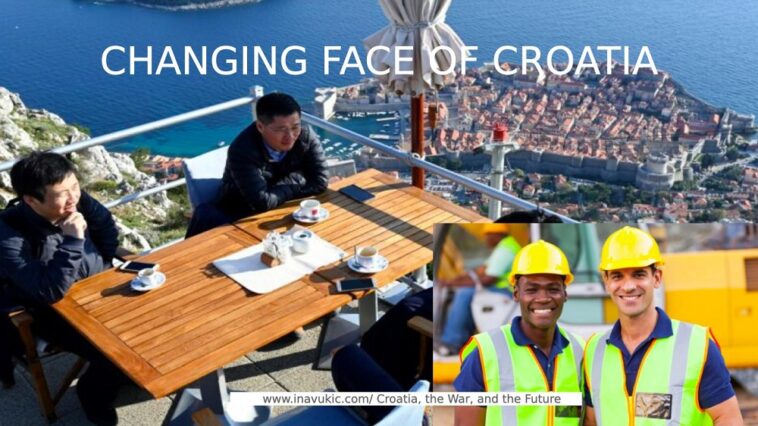On my last visit to Croatia the devastating earthquake in Zagreb in late March 2020, and dozens of smaller ones that followed, amidst extreme Covid 19 pandemic lockdowns that included public transport stoppage, saw me leave Croatia and return to Australia. Then more devastating earthquakes in December 2020 in Petrinja, Sisak, Glina and surrounding towns, nearby Zagreb, left the country in utter despair from ruins left, homeless people by the thousands.
Three years on the devastation caused by the earthquakes, despite ample solidarity funds offered by the European Union Solidarity Fund purses, to help finance the restoration of key infrastructure in the field of energy, water and wastewater, telecommunications, transport, health and education, not much until recently has been achieved in utilising those funds that in essence meant a lifeline for multitudes affected by the earthquakes. The word on the streets is that, incredulously, the Croatian government has, in the reality of lack of domestic labour, steered away from contracting the essential restoration building works to foreign companies. Indeed Croatia had continued seeing hundreds of thousands of work age people leave the country for a better life elsewhere. Some temporarily some permanently. Official statistics show some 450,000 have left Croatia in the past ten years, the bulk of working age, creating a demographic crisis for Croatia.
Furthermore, the EU Solidarity Funds are not designed to assist with the needed restoration of private homes and dwellings and the fact that most had had no insurance left people at the mercy of the poor national budget available for national disasters such as earthquakes. Nevertheless, recent legislative provisions address assistance to private residences damaged by the earthquakes. Owners or co-owners who are placed in containers or other forms of temporary accommodation will be supported at the expense of the state budget of the Republic of Croatia, as well as beneficiaries of the right to co-finance the rent, then owners or co-owners who are recipients of social welfare and persons with disabilities, in the status of veterans or other status according to a special law. The burning problem in the realisation of the latter financial supports lies in the fact that the state budget is inadequate to cover all needs in a timely manner.
Currently, Zagreb is akin to a lively building site. Earthquake damages on buildings and other infranstructures are being repaired on quite a large scale, as if racing against time. But then, general elections are due next year and the danger of losing the unused EU Solidarity Funds is real. The reluctance to engage foreign construction companies during the last couple of years has finally been replaced by import of foreign workers, many of whom are reportedly an unskilled labour force but as far as I can see, a hard-working labour force from China, India, Pakistan, Philippines, neighbouring countris like Bosnia and Herzegovina and Serbia etc.
This year, according to some estimates, up to 200,000 residence and work permits for foreigners could be issued in Croatia. More than 120,000 foreign workers have already been issued work permits and this is visible on construction sites, hospitality, waste management … As to solving the resulting homelessness from earthquakes devastation most affected families are still accommodated in converted shipping containers and mobile homes while others have moved temporarily to ancestral homes away from the devastated cities and towns.
There is almost no sector in Croatia that does not employ foreign workers. This affects all industries, not just construction. Croatian employers usually employ workers from the region. However, if they run out, they resort to those from distant countries particularly from the Far East. In the first three months of this year, the most foreign workers are from Bosnia and Herzegovina, followed by Nepal, Philippines, Serbia, India, Kosovo and North Macedonia. According to reliable surces every fifth construction worker in Croatia is a foreigner and this is pparent upon visiting the many constructin sites.
Currently, as many as about 520 agencies are active in Croatia for mediating the import of labour. Construction workers, delivery workers, caterers, cooks, postmen. Some industries rely more and more on foreign labour. Agencies are often shut down, and new ones are opened. There are more and more bad experiences, so foreigners pay to come, and then the working conditions in many cases are reported to be not even close to what they expected. Increased attention from government agencies is afoot, attending to curbing possible exploitation of foreign workers.
„Foreign workers must not be exploited but accepted as equal members of the economic system. People who today exploit workers in the worst way should be removed from the market, punished the most severely and thus show that we are not a society that profits from other people’s pain, but a country of opportunities for everyone,” concluded Irena Weber, chief director of the Croatian Association of Employers/HUP, at a gathering last week and said that we should not call those who exploit other people’s pain employers because they are not.
„I call on state institutions to resolve this as a matter of urgency ,” she said. https://novac.jutarnji.hr/novac/aktualno/poslodavci-zavapili-protiv-iskoristavanja-stranih-radnika-ministar-piletic-ispricao-bajku-o-potrazi-za-srecom-15332131
Employment Minister Marin Piletic, who addressed the gathering immediately after Weber, did not give the impression that he had heard what the chief director of HUP had said. He pointed out that in Croatia, “124,000 foreigners, a population larger than the city of Osijek, have sought happiness in Croatia”, that no one could have even thought of this a few years ago, when the number of foreigners was measured in several thousand, and that Croatia must start thinking about the Strategy for importing foreign workers.
„The Ministry of Internal Affairs has taken responsibility for adopting a Strategy on immigration policy for the first time by the end of 2023, not only on the import of labour, but also on the attraction of foreign students and the return of Croatian emigration,” Minister Piletic continued, not referring to everyday examples of reported exploitation of foreign workers, the slave-owning treatment some are exposed to and the lukewarm or no reaction of the state that Piletic represented.
Haphazzard approach to key problems and questions for the country have evidently defined Croatian governments for the last 25 years, since the final end od war of Serb occupation of parts of Croatia in 1998. I have written about that several times as Croatia transitioned from communism in ways that stifled demcracy and the rule of law, more than applied it. Corruption at all level incuding judiciary. National stratgies that would go hand in hand with the War of Independence values – practically nonexistent.
The current government that has taken the reins for the country in 2016, and those before it, have shouted from the rooftops the calls for Croatian diaspora to return to Croatia. But alas, this has been a mere lip service for political points. No national strategy developed or followed to enable and support such a return from the diaspora. Small steps such as the establihment of the State Office for Croats Living Abroad has been have been a disaster and more a vessel of photo-opportunity for government ministers to show the government’s „close” relationship to its diaspora than real actions to enable a return. Most Croats that have returned from the diaspora have been left to their own devices and knowhow than helped by the government with view to easing their transition into their ancestral homeland.
At least, we now have a changing picture on the streets of Croatia with foreign workers that should reap benefits for Croatia and a hope that the government will finally develop and adopt national strategies for the return of its Croat emigration. Suffice to say, Croatia’s demographic landscape is at crisis point and has been for at least a decade. Lots of talk in that period but little action to enable improve the demographics. Ina Vukic




